Waveform Self-Referencing Algorithm for Low-Repetition-Rate Laser Coherent Combination
Abstract
1. Introduction
2. Theoretical Foundation and Methodology
3. Simulation and Result Analysis
3.1. Two-Channel Combination Before Phase-Locking
3.2. Self-Referencing Waveform Construction
3.3. Two-Channel Coherent Combination After Phase-Locking
4. Discussion
4.1. The Performance of the WSRA Under Extended Conditions
4.2. Analysis of the WSRA Under Real Laboratory Conditions
5. Conclusions
Author Contributions
Funding
Institutional Review Board Statement
Informed Consent Statement
Data Availability Statement
Acknowledgments
Conflicts of Interest
References
- Özgören, K.; Öktem, B.; Yilmaz, S.; Ilday, F.Ö.; Eken, K. 83 W, 3.1 MHz, square-shaped, 1 ns-pulsed all-fiber-integrated laser for micromachining. Opt. Express 2011, 19, 17647–17652. [Google Scholar] [CrossRef] [PubMed]
- Quinn, M.; Jukna, V.; Ebisuzaki, T.; Dicaire, I.; Soulard, R.; Summerer, L.; Couairon, A.; Mourou, G. Space-based application of the CAN laser to LIDAR and orbital debris remediation. Eur. Phys. J. Spec. Top. 2015, 224, 2645–2655. [Google Scholar] [CrossRef]
- Jobling, A.I.; Findlay, Q.; Greferath, U.; Vessey, K.A.; Gunnam, S.; Morrison, V.; Venables, G.; Guymer, R.H.; Fletcher, E.L. Nanosecond laser induces proliferation and improved cellular health within the retinal pigment epithelium. Front. Med. 2025, 12, 1516900. [Google Scholar] [CrossRef]
- Yin, L.; Han, Z.; Shen, H.; Zhu, R. Suppression of inter-modal four-wave mixing in high-power fiber lasers. Opt. Express 2018, 26, 15804–15818. [Google Scholar] [CrossRef] [PubMed]
- Tao, R.; Xiao, H.; Zhang, H.; Leng, J.; Wang, X.; Zhou, P.; Xu, X. Dynamic characteristics of stimulated Raman scattering in high power fiber amplifiers in the presence of mode instabilities. Opt. Express 2018, 26, 25098–25110. [Google Scholar] [CrossRef]
- Zhang, C.; Xie, L.; Li, H.; Shen, B.; Feng, X.; Li, M.; Tao, R.; Wang, J. SRS-induced spatial-spectral distortion and its mitigation strategy in high-power fiber amplifiers. IEEE Photonics J. 2022, 14, 1–5. [Google Scholar] [CrossRef]
- Smith, A.V.; Do, B.T.; Hadley, G.R.; Farrow, R.L. Optical damage limits to pulse energy from fibers. IEEE J. Sel. Top. Quantum Electron. 2009, 15, 153–158. [Google Scholar] [CrossRef]
- Gao, W.; Zhao, B.; Fan, W.; Ju, P.; Zhang, Y.; Li, G.; Gao, Q.; Li, Z. Instability transverse mode phase transition of fiber oscillator for extreme power lasers. Opt. Express 2019, 27, 22393–22407. [Google Scholar] [CrossRef]
- Tajima, T.; Brocklesby, W.; Mourou, G. ICAN: The next laser powerhouse. Opt. Photonics News 2013, 24, 36–43. [Google Scholar]
- Glova, A.F. Phase locking of optically coupled lasers. Quantum Electron. 2003, 33, 283. [Google Scholar] [CrossRef]
- Goodno, G.D.; Book, L.D.; Rothenberg, J.E.; Weber, M.E.; Benjamin Weiss, S. Narrow linewidth power scaling and phase stabilization of 2-μm thulium fiber lasers. Opt. Eng. 2011, 50, 111608-111608. [Google Scholar] [CrossRef]
- Seise, E.; Klenke, A.; Breitkopf, S.; Limpert, J.; Tünnermann, A. 88 W 0.5 mJ femtosecond laser pulses from two coherently combined fiber amplifiers. Opt. Lett. 2011, 36, 3858–3860. [Google Scholar] [CrossRef] [PubMed]
- Bourderionnet, J.; Bellanger, C.; Primot, J.; Brignon, A. Collective coherent phase combining of 64 fibers. Opt. Express 2011, 19, 17053–17058. [Google Scholar] [CrossRef]
- Bellanger, C.; Toulon, B.; Primot, J.; Lombard, L.; Bourderionnet, J.; Brignon, A. Collective phase measurement of an array of fiber lasers by quadriwave lateral shearing interferometry for coherent beam combining. Opt. Lett. 2010, 35, 3931–3933. [Google Scholar] [CrossRef]
- Antier, M.; Bourderionnet, J.; Larat, C.; Lallier, E.; Lenormand, E.; Primot, J.; Brignon, A. kHz closed loop interferometric technique for coherent fiber beam combining. IEEE J. Sel. Top. Quantum Electron. 2014, 20, 182–187. [Google Scholar] [CrossRef]
- Vorontsov, M.A.; Carhart, G.W.; Ricklin, J.C. Adaptive phase-distortion correction based on parallel gradient-descent optimization. Opt. Lett. 1997, 22, 907–909. [Google Scholar] [CrossRef]
- Vorontsov, M.A.; Carhart, G.W.; Cohen, M.; Cauwenberghs, G. Adaptive optics based on analog parallel stochastic optimization: Analysis and experimental demonstration. J. Opt. Soc. Am. A 2000, 17, 1440–1453. [Google Scholar] [CrossRef]
- Wang, X.; Leng, J.; Zhou, P.; Ma, Y.; Xu, X.; Liu, Z. 1.8-kW simultaneous spectral and coherent combining of three-tone nine-channel all-fiber amplifier array. Appl. Phys. B 2012, 107, 785–790. [Google Scholar] [CrossRef]
- Ma, P.; Chang, H.; Ma, Y.; Su, R.; Qi, Y.; Wu, J.; Li, C.; Long, J.; Lai, W.; Chang, Q.; et al. 7.1 kW coherent beam combining system based on a seven-channel fiber amplifier array. Opt. Laser Technol. 2021, 140, 107016. [Google Scholar] [CrossRef]
- Shay, T.M. Theory of electronically phased coherent beam combination without a reference beam. Opt. Express 2006, 14, 12188–12195. [Google Scholar] [CrossRef]
- Shay, T.M.; Benham, V.; Baker, J.T.; Sanchez, A.D.; Pilkington, D.; Lu, C.A. Self-synchronous and self-referenced coherent beam combination for large optical arrays. IEEE J. Sel. Top. Quantum Electron. 2007, 13, 480–486. [Google Scholar]
- Jiang, W.; Gao, J.; Tan, G.; Zhang, M.; Dou, J.; Di, J.; Qin, Y. High environmentally adaptable phase control with reinforcement learning for coherent beam combination. Opt. Lasers Eng. 2024, 183, 108534. [Google Scholar] [CrossRef]
- Tünnermann, H.; Shirakawa, A. Deep reinforcement learning for coherent beam combining applications. Opt. Express 2019, 27, 24223–24230. [Google Scholar] [CrossRef]
- Jiang, M.; Wu, H.; An, Y.; Hou, T.; Chang, Q.; Huang, L.; Li, J.; Su, R.; Zhou, P. Fiber laser development enabled by machine learning: Review and prospect. PhotoniX 2022, 3, 16. [Google Scholar] [CrossRef]
- Zuo, J.; Jia, H.; Geng, C.; Bao, Q.; Zou, F.; Li, Z.; Jiang, J.; Li, F.; Li, B.; Li, X. Deep learning piston aberration control of fiber laser phased array by spiral phase modulation. J. Light. Technol. 2022, 40, 3980–3991. [Google Scholar] [CrossRef]
- Tan, G.; Jiang, W.; Gao, J.; Dou, J.; Zhong, L.; Di, J.; Qin, Y. Phase-locked control of the coherent beam combining system using dual-stream network and reinforcement learning. Opt. Lasers Eng. 2025, 186, 108830. [Google Scholar]
- Xie, Y.; Chernikov, F.; Mills, B.; Liu, Y.; Praeger, M.; Grant-Jacob, J.A.; Zervas, M.N. Single-step phase identification and phase locking for coherent beam combination using deep learning. Sci. Rep. 2024, 14, 7501. [Google Scholar] [CrossRef]
- Thomas, A.D.; Soni, K.; Nithyanadan, K. Physics based phase control in coherent beam combining systems. J. Light. Technol. 2024, 43, 824–831. [Google Scholar] [CrossRef]
- Zhou, H.; Tao, R.; Feng, X.; Zhang, H.; Li, M.; Xin, X.; Peng, Y.; Lin, H.; Wang, J.; Yan, L.; et al. Machine learning phase control of filled-aperture coherent beam combining: Principle and numerical demonstration. High Power Laser Sci. Eng. 2025, 13, 1–24. [Google Scholar] [CrossRef]
- Wang, X.; Zhou, P.; Ma, Y.; Ma, H.; Xu, X.; Liu, Z.; Zhao, Y. Coherent beam combining of pulsed fibre amplifiers with active phase control. Quantum Electron. 2011, 41, 1087. [Google Scholar] [CrossRef]
- Goodno, G.D.; Asman, C.P.; Anderegg, J.; Brosnan, S.; Cheung, E.C.; Hammons, D.; Injeyan, H.; Komine, H.; Long, W.H.; McClellan, M.; et al. Brightness-scaling potential of actively phase-locked solid-state laser arrays. IEEE J. Sel. Top. Quantum Electron. 2007, 13, 460–472. [Google Scholar] [CrossRef]
- Zhang, J.; Cao, J.; Hao, Q.; Cheng, Y.; Dong, L.; Xiong, K.; Han, B.; Liu, X. Window filtering algorithm for a low repetition rate pulsed laser coherent combination system. Appl. Opt. 2022, 61, 8484–8492. [Google Scholar] [CrossRef]
- Lombard, L.; Azarian, A.; Cadoret, K.; Bourdon, P.; Goular, D.; Canat, G.; Jolivet, V.; Jaouën, Y.; Vasseur, O. Coherent beam combination of narrow-linewidth 1.5 μm fiber amplifiers in a long-pulse regime. Opt. Lett. 2011, 36, 523–525. [Google Scholar] [CrossRef] [PubMed]
- Palese, S.; Cheung, E.; Goodno, G.; Shih, C.C.; Di Teodoro, F.; McComb, T.; Weber, M. Coherent combining of pulsed fiber amplifiers in the nonlinear chirp regime with intra-pulse phase control. Opt. Express 2012, 20, 7422–7435. [Google Scholar] [CrossRef] [PubMed]
- Su, R.; Zhou, P.; Wang, X.; Ma, P.; Xu, X. Actively coherent beam combining of two single-frequency 1083 nm nanosecond fiber amplifiers in low-repetition-rate. IEEE Photonics Technol. Lett. 2013, 25, 1485–1487. [Google Scholar] [CrossRef]
- Zou, F.; Zuo, J.; Geng, C.; Li, F.; Jiang, J.; Liu, J.; Zhou, X.; Fan, Z.; Ma, X.; Li, X. Indirectly coherent beam combining of pulsed lasers based on active control of continuous carrier. Opt. Eng. 2021, 60, 066111. [Google Scholar] [CrossRef]
- Jolivet, V.; Bourdon, P.; Bennai, B.; Lombard, L.; Goular, D.; Pourtal, E.; Canat, G.; Jaouen, Y.; Moreau, B.; Vasseur, O. Beam shaping of single-mode and multimode fiber amplifier arrays for propagation through atmospheric turbulence. IEEE J. Sel. Top. Quantum Electron. 2009, 15, 257–268. [Google Scholar] [CrossRef]
- Huang, Z.M.; Liu, C.; Li, J.; Zhang, D. A high-speed, high-efficiency phase controller for coherent beam combining based on SPGD algorithm. Quantum Electron. 2014, 44, 301. [Google Scholar] [CrossRef]
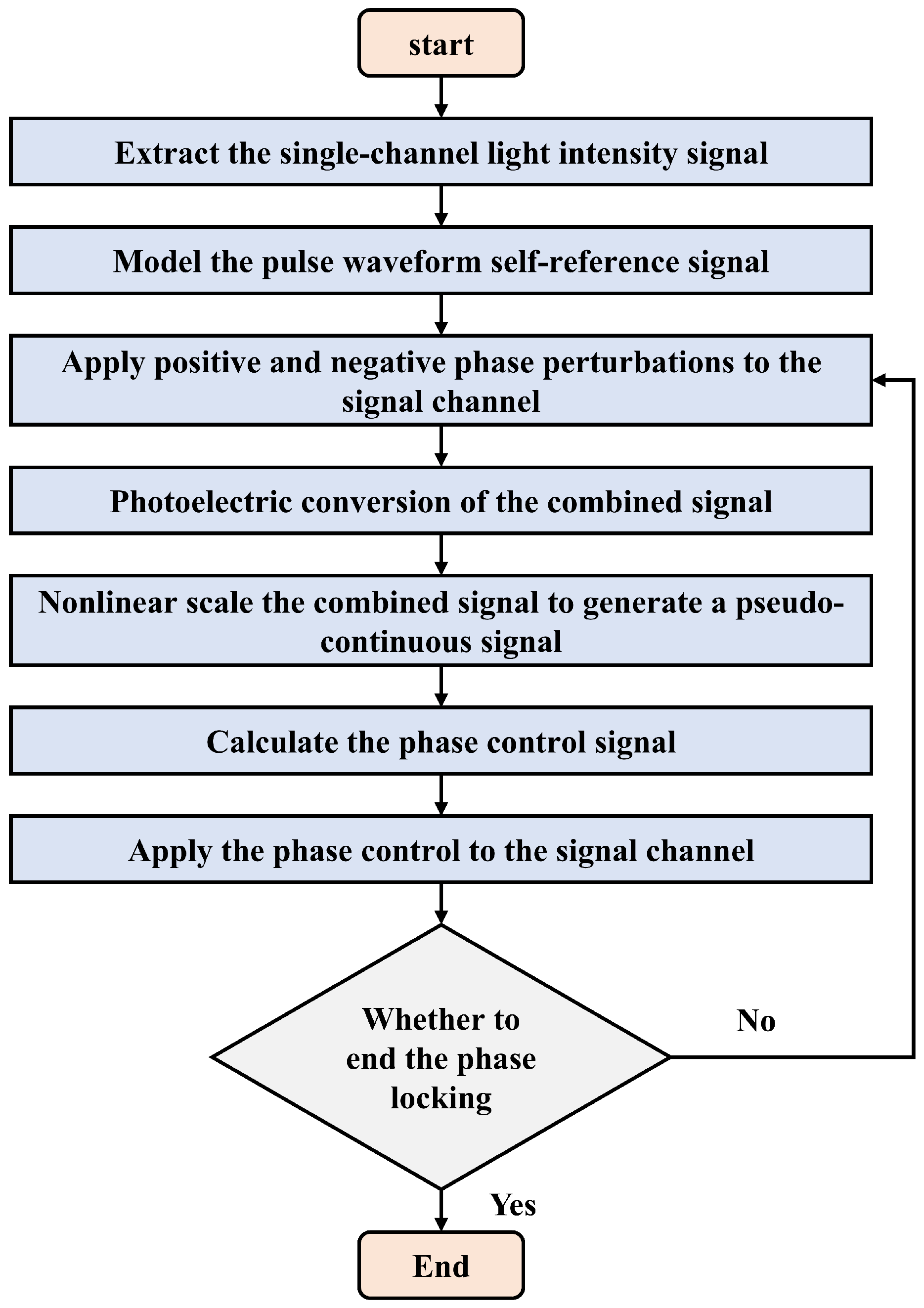

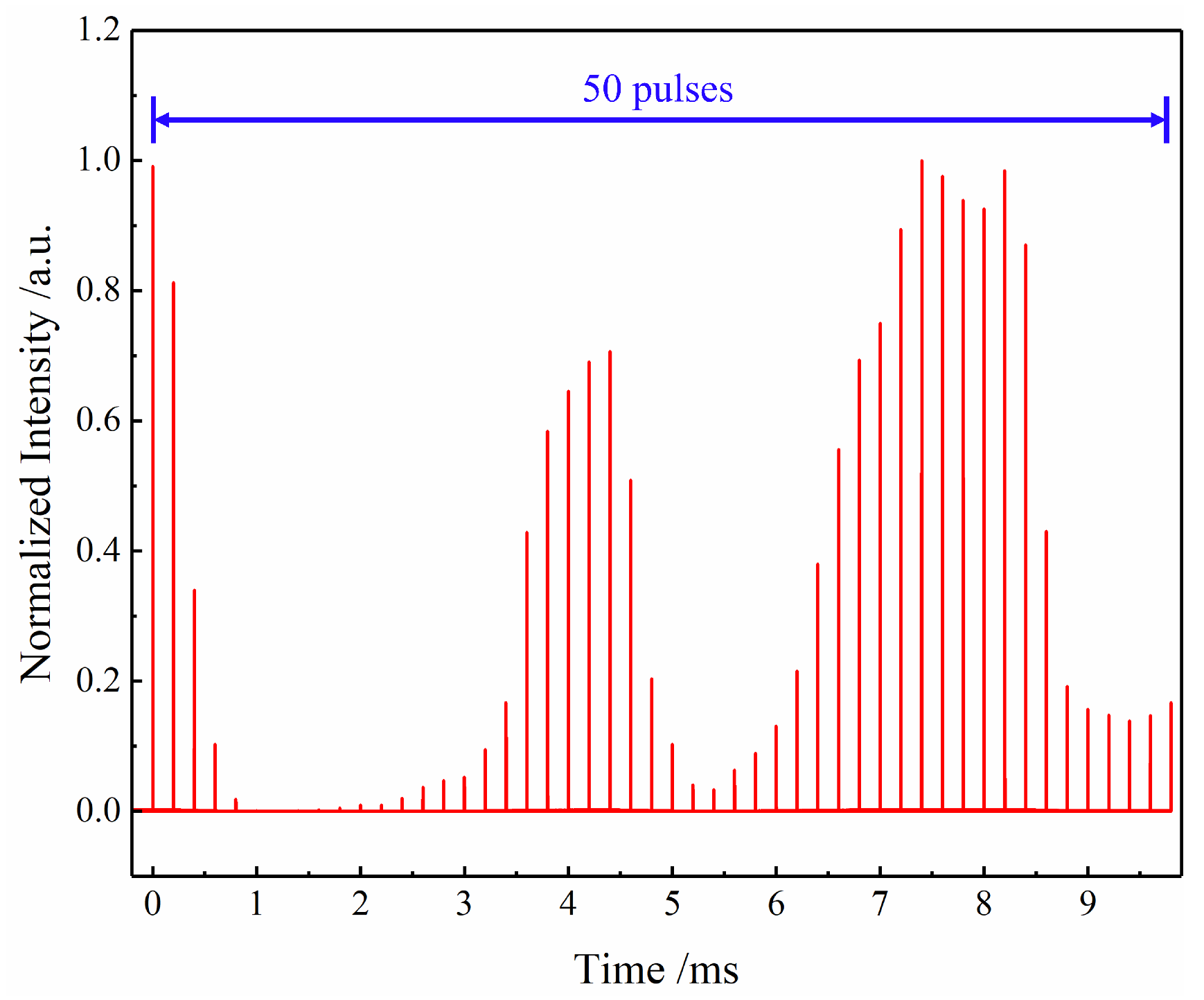
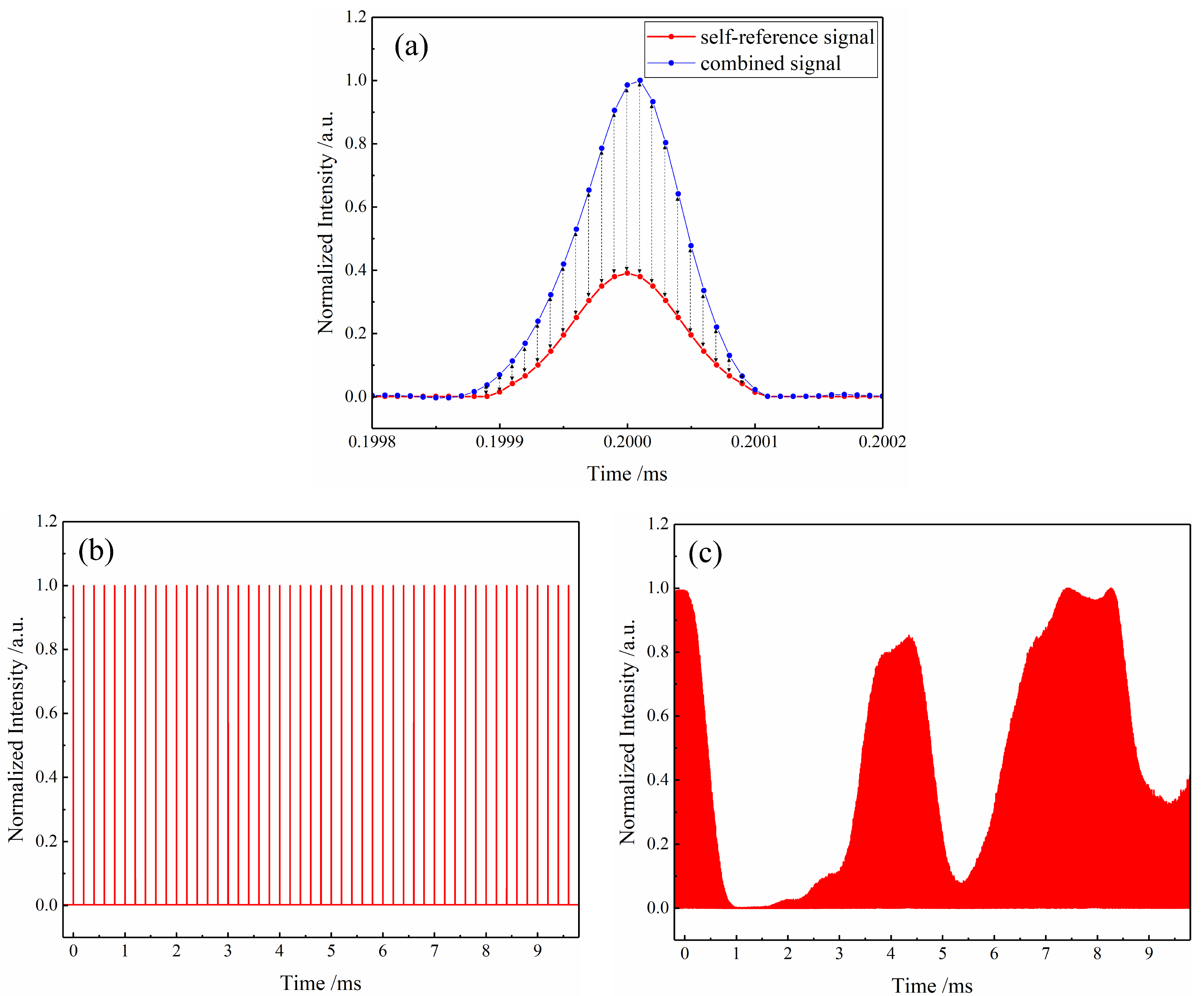
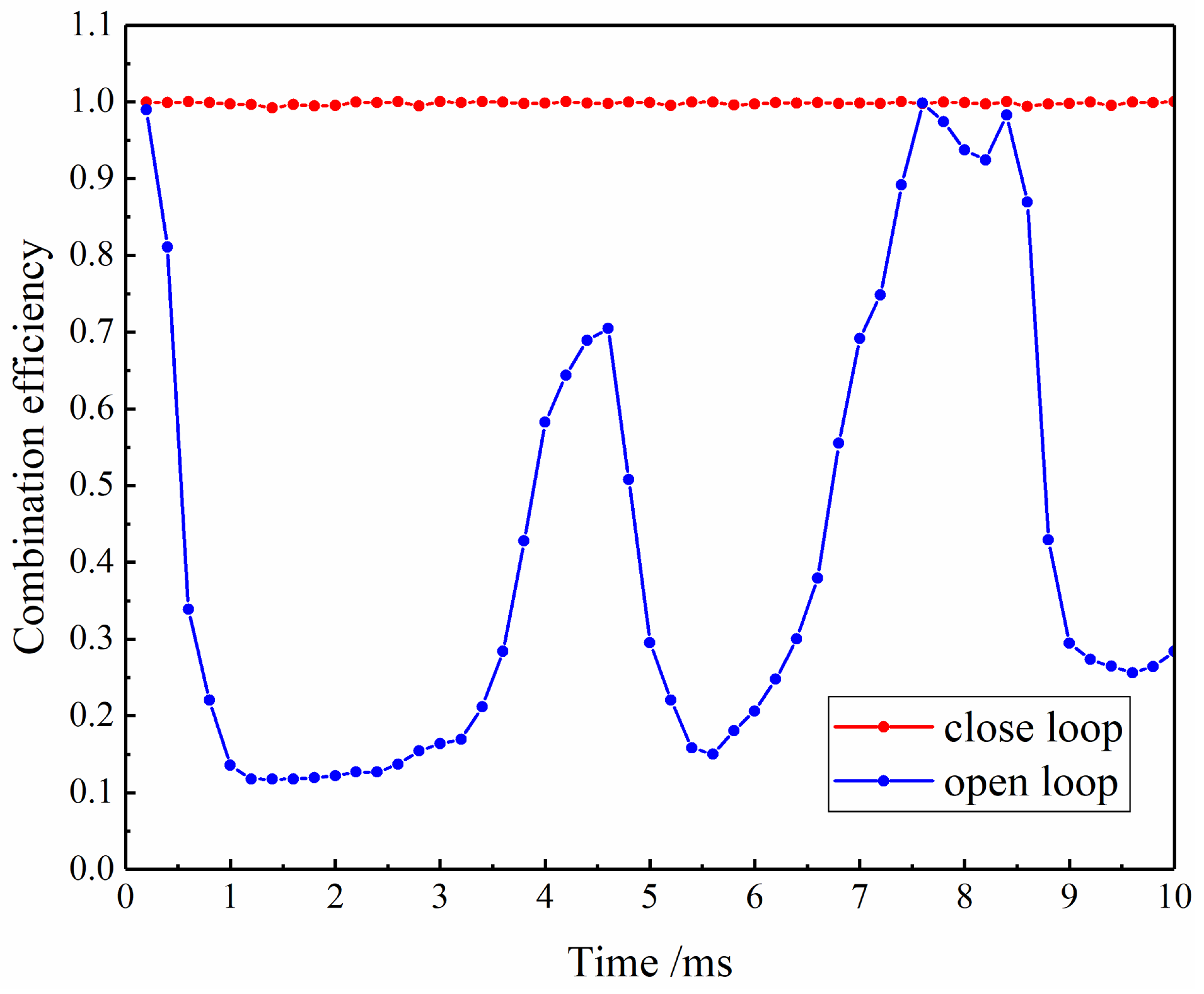

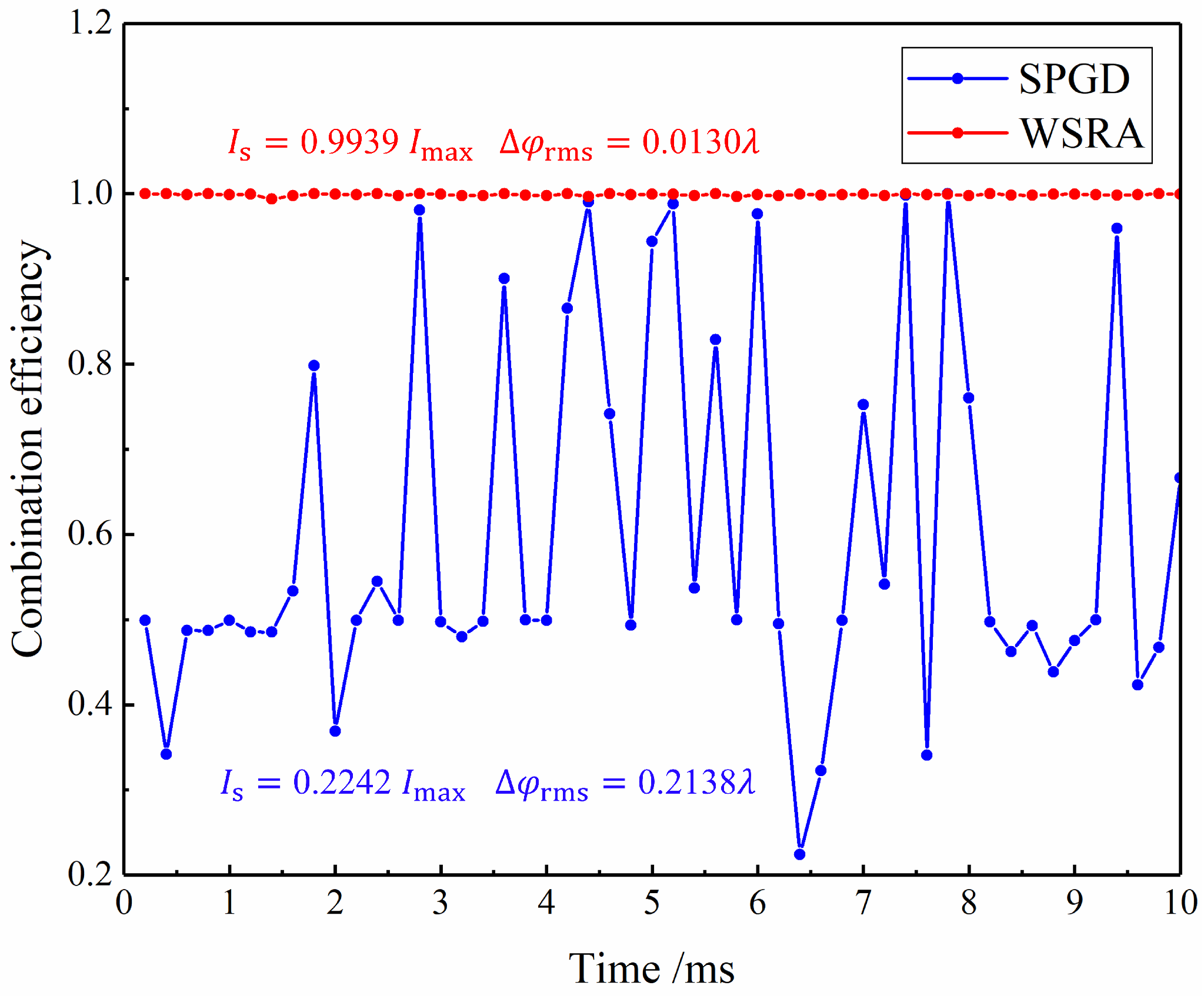

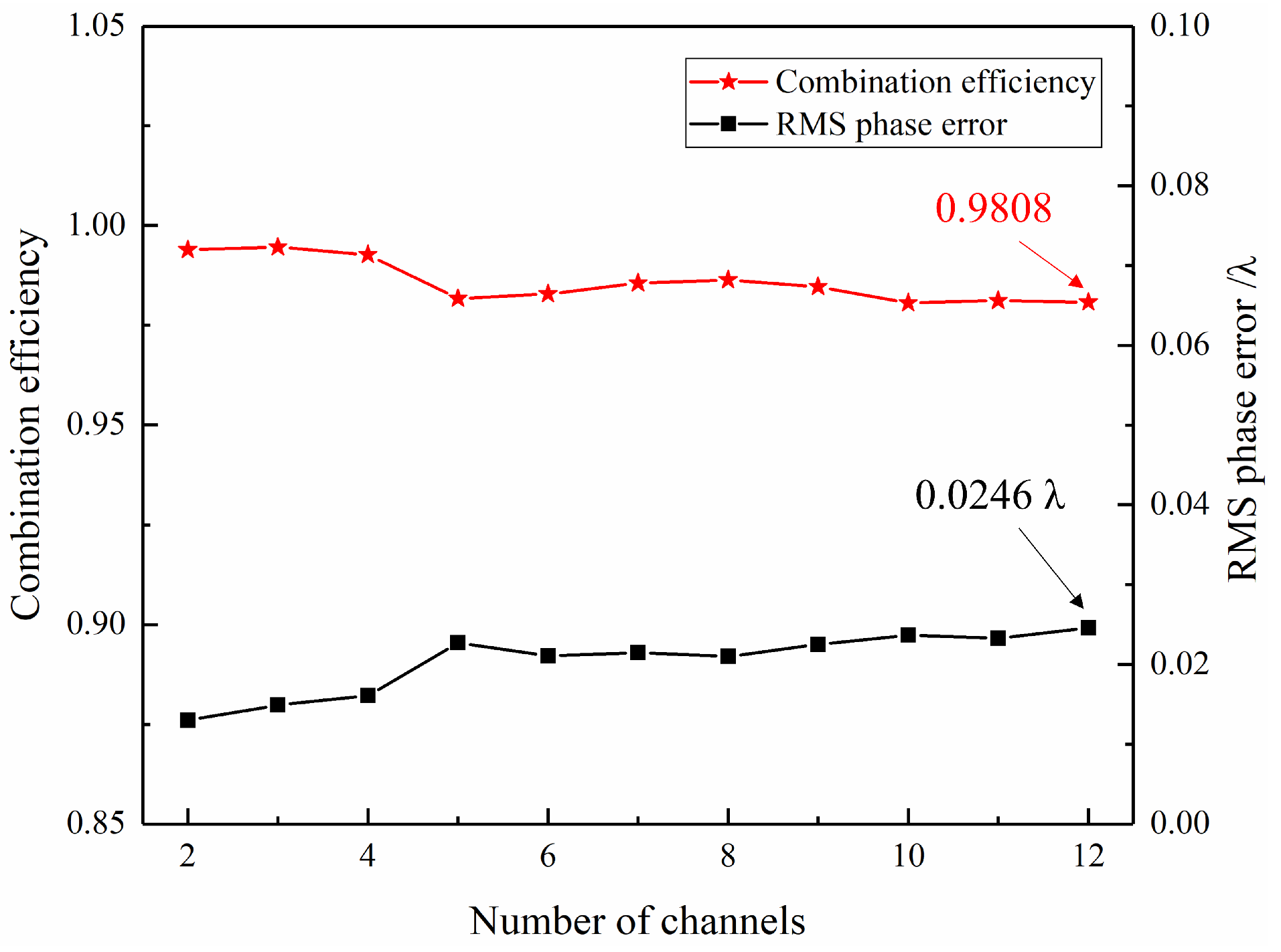
| Maximum Noise Amplitude | Combination Efficiency | RMS Phase Error |
|---|---|---|
| 1 | 0.9939 | 0.0130 |
| 2 | 0.9895 | 0.0150 |
| 3 | 0.9823 | 0.0130 |
| 4 | 0.9712 | 0.0231 |
| 5 | 0.9551 | 0.0284 |
| Channel Intensity Ratio | Combination Efficiency | RMS Phase Error |
|---|---|---|
| 3:1 | 0.9959 | 0.0111 |
| 2:1 | 0.9948 | 0.0122 |
| 1:1 | 0.9939 | 0.0130 |
| 1:2 | 0.9948 | 0.0122 |
| 1:3 | 0.9959 | 0.0111 |
| Waveform Pulse Width Deviation | Combination Efficiency | RMS Phase Error |
|---|---|---|
| −20 ns | 0.9409 | 0.0473 |
| −10 ns | 0.9843 | 0.0216 |
| 0 ns | 0.9939 | 0.0130 |
| 10 ns | 0.9625 | 0.0391 |
| 20 ns | 0.9038 | 0.0681 |
Disclaimer/Publisher’s Note: The statements, opinions and data contained in all publications are solely those of the individual author(s) and contributor(s) and not of MDPI and/or the editor(s). MDPI and/or the editor(s) disclaim responsibility for any injury to people or property resulting from any ideas, methods, instructions or products referred to in the content. |
© 2025 by the authors. Licensee MDPI, Basel, Switzerland. This article is an open access article distributed under the terms and conditions of the Creative Commons Attribution (CC BY) license (https://creativecommons.org/licenses/by/4.0/).
Share and Cite
Yang, Z.; Zhang, H.; Geng, D.; Huang, Y.; Zhang, J. Waveform Self-Referencing Algorithm for Low-Repetition-Rate Laser Coherent Combination. Appl. Sci. 2025, 15, 10430. https://doi.org/10.3390/app151910430
Yang Z, Zhang H, Geng D, Huang Y, Zhang J. Waveform Self-Referencing Algorithm for Low-Repetition-Rate Laser Coherent Combination. Applied Sciences. 2025; 15(19):10430. https://doi.org/10.3390/app151910430
Chicago/Turabian StyleYang, Zhuoyi, Haitao Zhang, Dongxian Geng, Yixuan Huang, and Jinwen Zhang. 2025. "Waveform Self-Referencing Algorithm for Low-Repetition-Rate Laser Coherent Combination" Applied Sciences 15, no. 19: 10430. https://doi.org/10.3390/app151910430
APA StyleYang, Z., Zhang, H., Geng, D., Huang, Y., & Zhang, J. (2025). Waveform Self-Referencing Algorithm for Low-Repetition-Rate Laser Coherent Combination. Applied Sciences, 15(19), 10430. https://doi.org/10.3390/app151910430







